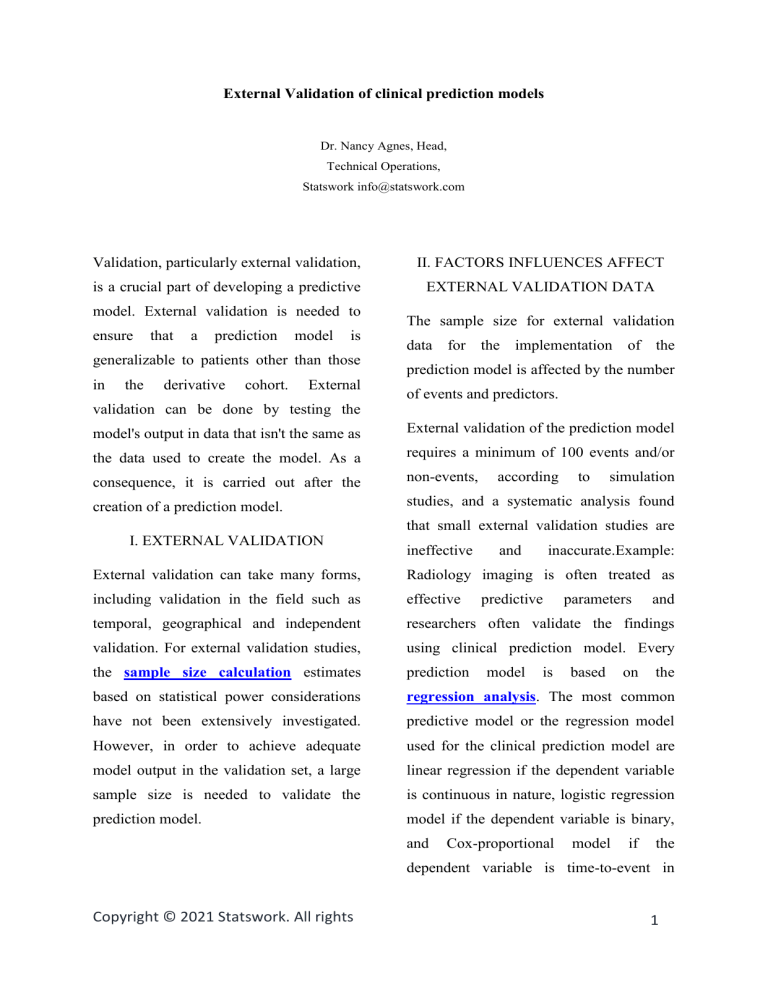
External Validation of clinical prediction models Dr. Nancy Agnes, Head, Technical Operations, Statswork info@statswork.com Validation, particularly external validation, II. FACTORS INFLUENCES AFFECT is a crucial part of developing a predictive EXTERNAL VALIDATION DATA model. External validation is needed to ensure that a prediction model is generalizable to patients other than those in the derivative cohort. External The sample size for external validation data for the implementation of the prediction model is affected by the number of events and predictors. validation can be done by testing the model's output in data that isn't the same as External validation of the prediction model the data used to create the model. As a requires a minimum of 100 events and/or consequence, it is carried out after the non-events, creation of a prediction model. studies, and a systematic analysis found according to simulation that small external validation studies are I. EXTERNAL VALIDATION ineffective and inaccurate.Example: External validation can take many forms, Radiology imaging is often treated as including validation in the field such as effective temporal, geographical and independent researchers often validate the findings validation. For external validation studies, using clinical prediction model. Every the sample size calculation estimates prediction based on statistical power considerations regression analysis. The most common have not been extensively investigated. predictive model or the regression model However, in order to achieve adequate used for the clinical prediction model are model output in the validation set, a large linear regression if the dependent variable sample size is needed to validate the is continuous in nature, logistic regression prediction model. model if the dependent variable is binary, and predictive model is Cox-proportional parameters based model on if and the the dependent variable is time-to-event in Copyright © 2021 Statswork. All rights 1 nature. Al-Ameri et al (2020) presented a identified the validity using the calibration detailed review on clinical prediction slope models for liver transplantation study. presented and the in sample the articles following are table Further, Ratna et al (2020) discussed the quality of clinical prediction model in vitro fertilisation and human reproduction. Validation of model has been carried out using re-sampling technique and measured the accuracy using AUC, calibration plot as shown in figure 1, c-index, and HosmerLemeshow test statistic. Figure 1: Slope of Calibration plot (Source: Stevens and Poppe (2020)) In addition, Stevens and Poppe (2020) suggested the Cox- calibration slope using logistic regression model instead of using simply the calibration slope for the predictive model. This suggestion has been made after the scrutiny of around 33 Table1.Stated Interpretation of the “Calibration Slope” Source: Stevens and Poppe (2020) Arjun et al (2020) considered the pandemic mortality study of COVID19 and discussed the development and validation of clinical prediction model. research articles and found that most of the validation are external validation and Copyright © 2021 Statswork. All rights 2 II. FUTURE SCOPE Though many literature suggests several validation techniques for the predictive model, there is no such proper technique which can be suitable for all the clinical datasets. Further, proper adjustment has to be made for the calibration index to validate the prediction model suitable for all clinical datasets. References: 1. 2. 3. 4. 5. Stevens, R. J. and Poppe, K. K. (2020). Validation of Clinical Prediction Models: What does the "Calibration Slope" Really Measure?. Journal of clinical epidemiology, 118, pp. 93– 99. Adibi, A., Sadatsafavi, M., Ioannidis, J. P. A. (2020). Validation and Utility Testing of Clinical Prediction Models: Time to Change the Approach. JAMA. 2020; 324(3):235–236. Ratna, M. B., Bhattacharya, S., Abdulrahim, B. and McLernon, D. L. (2020). A Systematic Review of the Quality of Clinical Prediction Models in Vitro Fertilisation, Human Reproduction, 35(1), pp. 100–116 Arjun S Yadaw., Yan-chak Li., Sonali Bose., Ravi Iyengar., Supinda Bunyavanich., Gaurav Pandey. (2020). Clinical Features of COVID19 Mortality: Development and Validation of a Clinical Prediction Model, The Lancet Digital Health, 2(10), pp. 516-525. Al‐Ameri, A.A.M., Wei, X., Wen, X., Wei, Q., Guo, H., Zheng, S. and Xu, X. (2020), Systematic review: risk prediction models for recurrence of hepatocellular carcinoma after liver transplantation. Transpl Int, 33, pp. 697712. Copyright © 2021 Statswork. All rights 3
